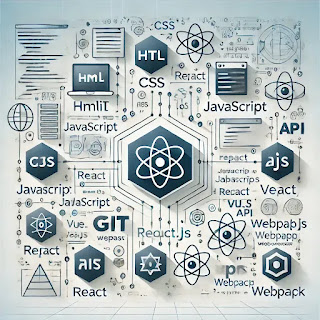As technology evolves, the distinction between front-end and back-end development blurs, giving rise to the full-stack developer—a professional who handles both client and server-side development. In this blog, we will focus on **full-stack front-end web development**, which refers to the expanded role of front-end developers beyond just HTML, CSS, and JavaScript. Modern front-end developers often need to manage tools and workflows that blur into full-stack territory, such as version control, APIs, and performance optimization.
This blog explores the role of a full-stack front-end developer, the key technologies involved, and how to build the necessary skill set.
Introduction: What is Full-Stack Front-End Development?
Traditionally, front-end developers focus solely on the user interface—using HTML, CSS, and JavaScript to create the visible parts of a website or application. However, modern front-end development encompasses more responsibilities. Today, front-end developers must work with APIs, handle state management, optimize performance, and even configure servers, which pushes them into full-stack development territory.
A full-stack front-end developer is someone who:
- Builds and maintains user interfaces using modern frameworks like React, Vue.js, or Angular.
- Manages state and handles data flow between the front-end and back-end via APIs.
- Optimizes application performance and improves loading times.
- Configures tools like Webpack, Git, and Continuous Integration (CI) services.
### **1. Core Technologies in Full-Stack Front-End Development**
While the front-end starts with HTML, CSS, and JavaScript, modern full-stack front-end development involves a wide range of tools and technologies:
#### **HTML, CSS, and JavaScript: The Foundations**
- **HTML (Hypertext Markup Language)** defines the structure of the webpage.
- **CSS (Cascading Style Sheets)** is used to style the visual appearance of the site, from layout to typography.
- **JavaScript** adds interactivity and logic to the page, enabling dynamic content.
Though these are fundamental, a full-stack front-end developer needs more than just these core languages.
#### **Modern JavaScript Frameworks**
Frameworks like **React**, **Vue.js**, and **Angular** streamline front-end development, making it easier to build complex applications with reusable components and maintainable codebases.
- **React** is known for its component-based architecture and flexibility.
- **Vue.js** offers an intuitive, simple-to-learn framework, ideal for smaller to mid-sized applications.
- **Angular** provides a complete solution for larger, enterprise-level applications with built-in tools and services.
#### **State Management**
For complex applications, managing the application’s state (the data that the app needs to track) can be challenging. Tools like **Redux**, **Vuex**, or **Context API** (in React) help keep state management efficient and predictable.
#### **API Integration**
A full-stack front-end developer often communicates with back-end services to retrieve data. This involves using:
- **REST APIs**: The most common way for the front-end to interact with back-end services, where data is exchanged in formats like JSON or XML.
- **GraphQL**: An alternative to REST, allowing more flexible querying of data, which can improve performance in certain scenarios.
### **2. Full-Stack Workflows and Tools**
Full-stack front-end development requires an understanding of workflows and tools that improve productivity, manage code, and optimize applications.
#### **Version Control (Git)**
Git is essential for tracking code changes, collaborating with teams, and managing codebases. Platforms like **GitHub** or **GitLab** integrate version control with CI/CD pipelines to automate deployment processes.
#### **Build Tools (Webpack, Vite, Parcel)**
Modern web applications often require bundling and compiling of JavaScript files, CSS preprocessing, and other optimizations. Tools like **Webpack** automate these tasks, ensuring that your app is as efficient as possible.
#### **Package Managers (npm, Yarn)**
To manage dependencies, full-stack front-end developers use package managers like **npm** or **Yarn**. These tools help install, update, and manage libraries used in the project.
### **3. Front-End Performance Optimization**
When handling the front-end, performance optimization is key to ensuring that applications run smoothly across different devices and internet speeds.
#### **Minimizing and Bundling Assets**
Tools like Webpack bundle JavaScript, CSS, and images into smaller files, reducing load times. **Minifying** files—removing unnecessary spaces, characters, and comments—also helps improve speed.
#### **Lazy Loading**
Lazy loading delays the loading of images or components until they are needed (i.e., when they come into view). This technique speeds up the initial load time of a webpage, improving the user experience.
#### **Caching and Service Workers**
Service workers and caching strategies (like using **Progressive Web Apps** or PWAs) can provide a fast, offline-friendly experience. Service workers cache files on the client-side, ensuring that the application remains functional even without internet access.
### **4. Testing and Debugging Tools**
To ensure code quality, full-stack front-end developers use various testing and debugging tools.
- **Unit Testing**: Libraries like **Jest** or **Mocha** allow for unit tests that verify individual components or functions behave as expected.
- **End-to-End Testing**: Tools like **Cypress** or **Selenium** simulate user interactions, ensuring that the application functions correctly from start to finish.
- **DevTools**: Browser DevTools (available in Chrome, Firefox, etc.) allow developers to inspect elements, debug JavaScript, and analyze performance metrics.
### **5. Continuous Integration and Deployment (CI/CD)**
CI/CD workflows ensure that new features and updates are continuously tested and deployed without disrupting the user experience. Full-stack front-end developers often use CI/CD pipelines to automate testing, building, and deployment processes.
Tools like **Jenkins**, **Travis CI**, or **CircleCI** can be integrated with platforms like GitHub to automate these tasks.
### **6. Learning and Growing in Full-Stack Front-End Development**
To become a successful full-stack front-end developer, consistent learning and hands-on experience are key. Some great ways to continue learning include:
- **Contributing to Open-Source Projects**: Gain real-world experience by collaborating with the community.
- **Building Full Projects**: Move from simple components to building complete applications that involve API integration, state management, and performance optimization.
- **Keeping Up with Trends**: Follow blogs, join online communities, and attend conferences to stay updated on the latest tools and practices in the industry.
### **Conclusion: A Future-Proof Skill Set**
Being a full-stack front-end developer means you not only handle the user interface but also navigate the complexities of workflows, data management, and performance optimization. Mastering these skills will make you invaluable in the modern web development ecosystem, positioning you as a well-rounded professional capable of building fast, scalable, and user-friendly web applications.
Whether you're an aspiring developer or looking to broaden your current skill set, full-stack front-end development offers endless opportunities to innovate and grow.






Comments
Post a Comment